






The Interior
What follows is a series of photographs taken outside the Capital Area of Greater Muscat.
A good third of the country is quite mountainous with Jebel Shams, at some 3,000 meters (10,000 feet), the
highest point in the country. Up there, even at the height of the summer when temperatures down below can be brutally
hot -- 50Celsius (122F) is not uncommon -- the thermometer rarely climbs higher than about 30 C (86F), making the
top of the mountain one of the more pleasant places to be in the Sultanate at that time of year.

These boys were taking in the scene in the streets of a small village
high up Wadi Beni Kharous to the south of Rustaq, a major date-growing center to the west of the Capital Area.
"Wadi" is the Arabic word for the Spanish "arroyo", sometimes called a "dry wash"
or a "dry riverbed" in English.
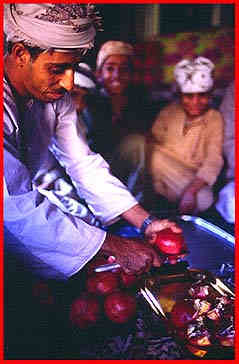
Omani Hospitality
It is not at all unusual to be invited into someone's home
for refreshments if you're out and about in the villages.
Here, in a small town at the top of Wadi Beni Kharous,
our host prepared pomegranates for us to eat while boys
of the village looked on.
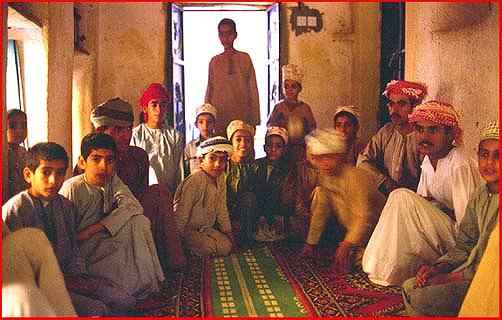
Beni Kharousi Boys
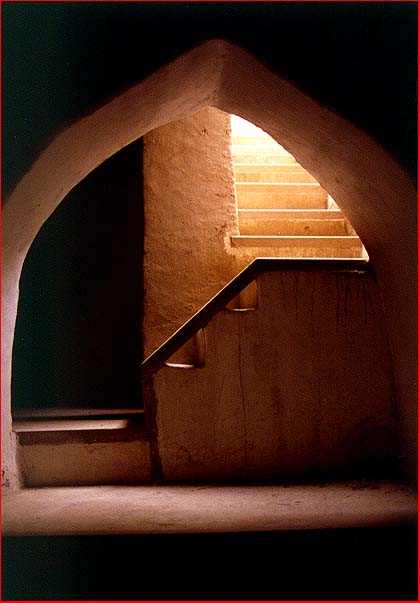
Bidbid Stairway
This staircase is in an old fort in Bidbid, a town some 80 km from
Muscat on the way to both Sur and Nizwa. The building is several
hundred years old.

Nizwa High Street
This shot looks down on the business district, one-time
capital of Oman and present-day wilayat (provincial) capital
in the foothills of the Jebel Akhdar some 180 km to the
southwest of Muscat. The Friday Market is a favorite
spot for a day out for tourists and expats alike.


Nizwa Fort
The ancient Nizwa Fort, which has been restored and refurbished
in recent years, is a testament to the stalwartness of the Omani
people, and dominates the silhouette of the city.

On the Way to Jebel Shams
The drive up to Jebel Shams from the main highway from Nizwa
is always a dramatic experience, not least if you make the trip in
early morning or early evening when the sun is low and the light is
warm and golden. On this trip there is never any question of boredom.
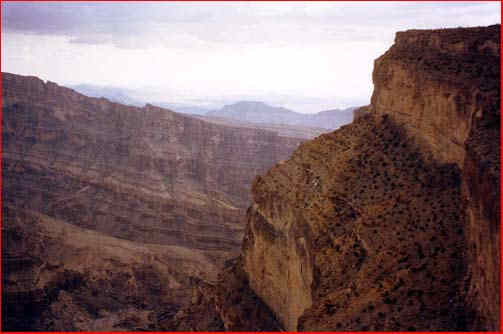
"The Grand Canyon"
After driving for some 40 minutes up a steep, winding, gravel road you come
to a turn-off not far from a military listening post at the top of the mountain.
A bumpy track leads down to a flat area where most people park. You walk
some 50 meters to the edge. In a sense, the bottom falls out of the world,
for far beneath you -- nearly a kilometer, in fact -- you can just see the roofs
of the village of Ghul. Looking around, you realize that you are looking at
a scene that is very, very reminiscent of a side canyon of Arizona's Grand
Canyon in the US. The colors aren't as spectacular, but the geological for-
mations are. Actually, there is one school of thought that suggests that this
canyon was once a cave and that the roof collapsed a few million years ago.
Whatever the truth is, the view is spectacular.

This was taken at a different time of year, so the colors are rather different,
too. Sedimentary styriations are clearly visible, and far below you can see
Wadi Ghul, which was running at the time. Jebel Shams, like the rest of Oman,
is a geologist's dream, a natural laboratory.

This gives you a somewhat better sense of the depth of the
chasm. Unlike Grand Canyon National Park, there are no guard
rails here -- nor are there any nicely prepared paths to follow.

Family of Weavers
Surprisingly, there are two or three small families of
weavers who live within a few dozen meters of the drop-off
in rough stone cottages. They herd a few goats and sheep and use their
wool to weave heavy pieces of fabric which can be used as wall
hangings, horse/camel blankets, or whatever.

Spinner & Weaver
Here you see two men, one spinning yarn in the background while
the other works on a piece of fabric. The loom and the spindle both
remind me greatly of similar equipment used by Guatemalan and
Peruvian Indians to produce similar products. The difference: In
Oman it is the men who do the work; in Latin America it's the women.
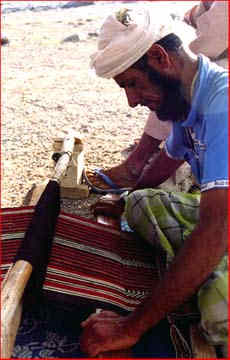
Jebel Shams Weaver
This man was concentrating so intently on his work that
he took absolutely no notice of me while I photographed him.
I suppose I should have bought the piece, but I didn't...

















